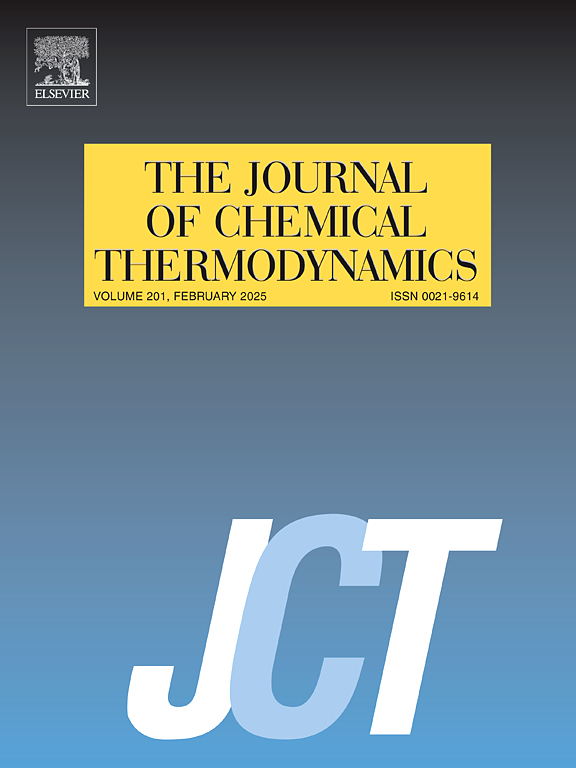液态乙烷和乙烷+丙烷二元混合物的导热性测量结果
IF 2.2
3区 工程技术
Q3 CHEMISTRY, PHYSICAL
引用次数: 0
摘要
利用瞬态热线装置,在温度为 146-247 K、压力为 14 MPa 的液相条件下测量了乙烷的热导率。在温度为 156-288 K 和压力为 25 MPa 的液相条件下,测量了乙烷和丙烷二元混合物的热导率。二元体系中乙烷的摩尔分数分别为 0.198、0.525 和 0.736。实验结果与 REFPROP 计算结果的偏差在乙烷和混合物的 3% 以内。随后,利用之前通过尺寸分析得出的热导率模型来预测正构烷烃混合物的热导率。首先通过混合规则获得混合物临界参数,然后计算混合物的热导率。将乙烷的实验数据与之前构建的正构烷烃模型进行比较,得出平均绝对相对偏差(AARD)为 4.42%。同样,将乙烷+丙烷混合物的实验数据与本研究提出的混合物预测模型进行比较,得出的平均绝对相对偏差为 1.92%。实验数据与模型计算结果之间的相对偏差显示出良好的一致性。本文章由计算机程序翻译,如有差异,请以英文原文为准。
Thermal conductivity measurements of liquid ethane and ethane + propane binary mixtures
Based on the transient hot-wire apparatus, the thermal conductivity of ethane was measured in the temperature range of 146–247 K and pressure < 14 MPa in the liquid phase. The thermal conductivity of ethane + propane binary mixture was measured in the temperature range of 156–288 K and pressure < 25 MPa in the liquid phase. The mole fractions of ethane in binary systems are 0.198, 0.525, and 0.736. The deviation between experimental results and REFPROP calculation falls within 3 % of ethane and mixture. Subsequently, the previous established thermal conductivity model, derived from dimensional analysis, was employed to predict the thermal conductivity of n-alkanes mixture. The mixture critical parameters were obtained first by the mixing rules, and the thermal conductivity of the mixture were calculated. Comparisons were made between the experimental data of ethane and the previously constructed n-alkane model, resulting in an average absolute relative deviation (AARD) of 4.42 %. Similarly, the experimental data of the ethane + propane mixture was compared with the mixture prediction model proposed in this study, yielding an AARD of 1.92 %. The relative deviation between experimental data and model calculations demonstrates good consistency.
求助全文
通过发布文献求助,成功后即可免费获取论文全文。
去求助
来源期刊

Journal of Chemical Thermodynamics
工程技术-热力学
CiteScore
5.60
自引率
15.40%
发文量
199
审稿时长
79 days
期刊介绍:
The Journal of Chemical Thermodynamics exists primarily for dissemination of significant new knowledge in experimental equilibrium thermodynamics and transport properties of chemical systems. The defining attributes of The Journal are the quality and relevance of the papers published.
The Journal publishes work relating to gases, liquids, solids, polymers, mixtures, solutions and interfaces. Studies on systems with variability, such as biological or bio-based materials, gas hydrates, among others, will also be considered provided these are well characterized and reproducible where possible. Experimental methods should be described in sufficient detail to allow critical assessment of the accuracy claimed.
Authors are encouraged to provide physical or chemical interpretations of the results. Articles can contain modelling sections providing representations of data or molecular insights into the properties or transformations studied. Theoretical papers on chemical thermodynamics using molecular theory or modelling are also considered.
The Journal welcomes review articles in the field of chemical thermodynamics but prospective authors should first consult one of the Editors concerning the suitability of the proposed review.
Contributions of a routine nature or reporting on uncharacterised materials are not accepted.
 求助内容:
求助内容: 应助结果提醒方式:
应助结果提醒方式:


